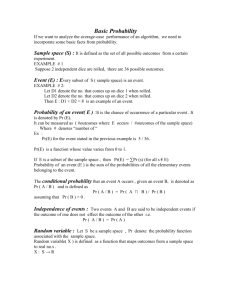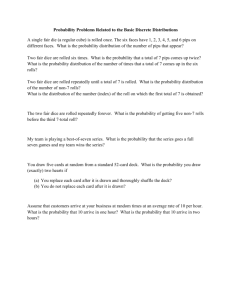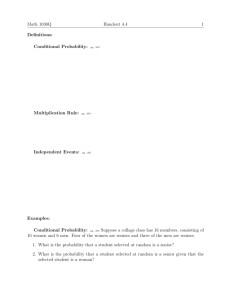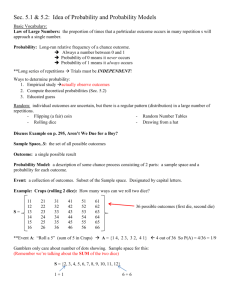CCSS Weekly Problems: Probability Name Choose 7 to do Date
advertisement
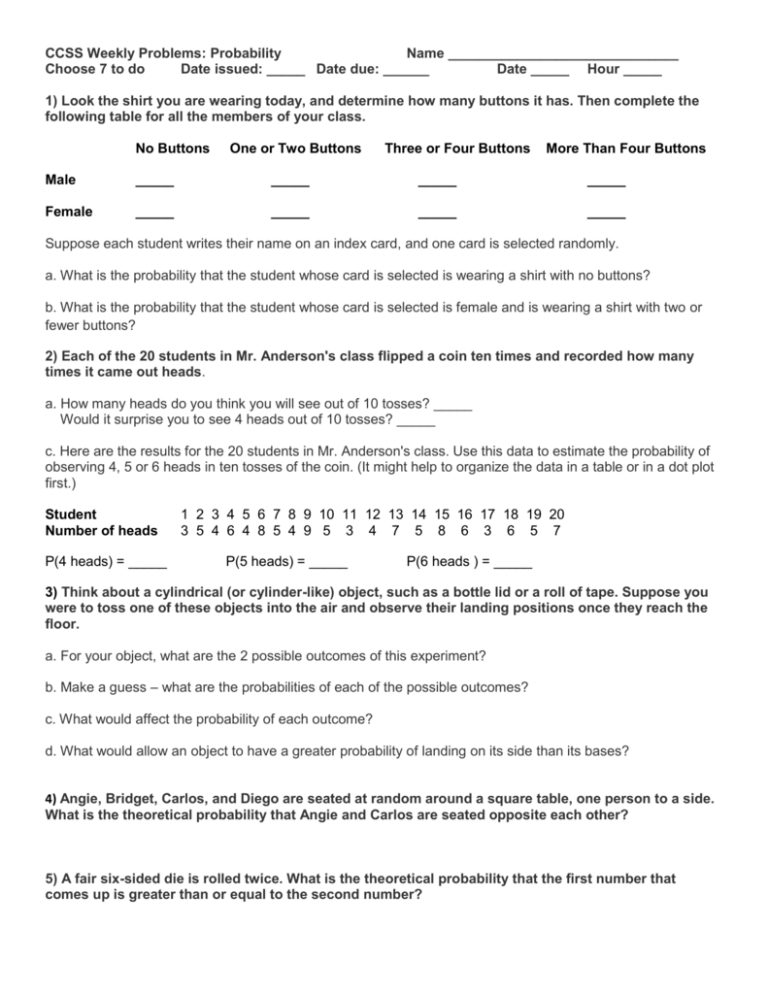
CCSS Weekly Problems: Probability Name ______________________________ Choose 7 to do Date issued: _____ Date due: ______ Date _____ Hour _____ 1) Look the shirt you are wearing today, and determine how many buttons it has. Then complete the following table for all the members of your class. No Buttons One or Two Buttons Three or Four Buttons More Than Four Buttons Male _____ _____ _____ _____ Female _____ _____ _____ _____ Suppose each student writes their name on an index card, and one card is selected randomly. a. What is the probability that the student whose card is selected is wearing a shirt with no buttons? b. What is the probability that the student whose card is selected is female and is wearing a shirt with two or fewer buttons? 2) Each of the 20 students in Mr. Anderson's class flipped a coin ten times and recorded how many times it came out heads. a. How many heads do you think you will see out of 10 tosses? _____ Would it surprise you to see 4 heads out of 10 tosses? _____ c. Here are the results for the 20 students in Mr. Anderson's class. Use this data to estimate the probability of observing 4, 5 or 6 heads in ten tosses of the coin. (It might help to organize the data in a table or in a dot plot first.) Student Number of heads P(4 heads) = _____ 1 2 3 4 5 6 7 8 9 10 11 12 13 14 15 16 17 18 19 20 3 5 4 6 4 8 5 4 9 5 3 4 7 5 8 6 3 6 5 7 P(5 heads) = _____ P(6 heads ) = _____ 3) Think about a cylindrical (or cylinder-like) object, such as a bottle lid or a roll of tape. Suppose you were to toss one of these objects into the air and observe their landing positions once they reach the floor. a. For your object, what are the 2 possible outcomes of this experiment? b. Make a guess – what are the probabilities of each of the possible outcomes? c. What would affect the probability of each outcome? d. What would allow an object to have a greater probability of landing on its side than its bases? 4) Angie, Bridget, Carlos, and Diego are seated at random around a square table, one person to a side. What is the theoretical probability that Angie and Carlos are seated opposite each other? 5) A fair six-sided die is rolled twice. What is the theoretical probability that the first number that comes up is greater than or equal to the second number? 6) A seven-year-old boy has a favorite treat, Super Fruity Fruit Snax. These "Fruit Snax" come in pouches of 10 snack pieces per pouch. The pouches are generally sold by the box, with each box containing 4 pouches. The snack pieces come in 5 different fruit flavors, and usually each pouch contains at least one piece from each of the 5 flavors. The website of the company that manufactures the product says that equal numbers of each of the 5 fruit flavors are produced and that pouches are filled in such a way that each piece added to a pouch is equally likely to be any one of the five flavors. Of all the 5 fruit flavors, the seven-year-old boy likes mango the best. One day, he was very disappointed when he opened a pouch and there were no (zero) mango flavored pieces in the pouch. His mother (a statistician) assured him that this was no big deal and just happens by chance sometimes. a. If the information on the company's website is correct, what proportion of the population of snack pieces is mango flavored? b. On average, how many mango flavored pieces should the boy expect in a pouch of 10 snack pieces? c. What is the chance that a pouch of 10 would have no mango flavored pieces? (multiply the chances of that happening each time one is added) 7) Roll two dice 10 times. After each roll, note whether any sixes were observed and record your results in the table below. Roll Any Sixes?(Y (circle) 1 2 3 4 5 6 7 8 9 10 a. What portion of the 10 rolls resulted in at least one six? b. Contemplate all the different possible outcomes that might be observed when two dice are rolled. (There are 36 different possible outcomes.) What is the probability that at least one 6 occurs? 8) Flip a coin ten times. Record if you flip heads. Flip a head?(Y (circle) 1 2 3 4 a. What proportion of the 10 flips resulted in a head? c. Make a list of all the different possible outcomes that might be observed when two dice are rolled. (There are 16 different possible outcomes.) d. What portion of the 16 possible outcomes results in at least one head? e. Suppose you and your classmates were able to flip a coin thousands of times. What portion of the time would you expect to flip at least one tail? f. What mathematician has a “triangle” named after him detailing these results? 9) Many games use dice which are six-sided and fair (meaning each face on the die is equally likely to land face up). Many games also use the sum of two dice rolled at the same time to determine movement of game pieces. However, not all dice are six-sided. Imagine a game in which two fair foursided (tetrahedral) dice are rolled simultaneously. These dice are in the shape of a pyramid, and when a die is rolled, the outcome is determined by the side that lands face down. Suppose that for these two dice, the possible values (corresponding to the four sides of the die) that can be obtained from each die are as follows: Die #1: 1, 2, 3, or 4 Die #2: 2, 4, 6, or 8 a. A certain game determines the movement of players' game pieces based on the SUM of the numbers on the face down sides when two dice are rolled. There are 10 distinct sum values that can occur, and some of those sums occur more often than others. i. Using an organized list, table, tree diagram, or method of your choosing, develop a list of all 16 possible outcomes (for example, Die #1 = 1 and Die #2 = 2 for a sum of 3; Die #1 = 1 and Die #2 = 4 for a sum of 5; and so on). ii. From your work in part a., determine the 10 distinct sum values that are possible and calculate the probability of obtaining each sum value. Note: as mentioned above, some values will occur more frequently than others. P(sum of 3) = P(sum of 4) = P(sum of 5) = P(sum of 6) = P(sum of 7) = P(sum of 8) = P(sum of 9) = P (sum of 10) = P(sum of 11) = P(sum of 12) = iii. Using your work in part b., answer the following questions: What is the probability of obtaining a sum that is > 5? What is the probability of obtaining a sum that is at most (≤) 5? What is the probability of obtaining a sum that is at least (≥) 5? 10) (see #9 for type of dice) Now consider the case where the DIFFERENCE in the numbers on the face down sides when two dice are rolled is important to the game. Unless the two die values are the same (in which case the difference is 0), the difference for purposes of this game will always be computed as the larger number value rolled minus the smaller number value rolled. In this way, the difference value for any roll of the two dice will always be positive or 0. i. Using an organized list, table, tree diagram, or method of your choosing, develop a list of all 16 possible outcomes (for example, Die #1 = 1 and Die #2 = 2 for a difference of 1; Die #1 = 1 and Die #2 = 4 for a difference of 3; and so on). ii. From your work in part d., determine the 8 distinct difference values that are possible and calculate the probability of obtaining each difference value. Note: as mentioned above, some values will occur more frequently than others. P(0) = P(1) = P(2) = P(3) = P(4) = P(5) = P(6) = P(7) = iii. Using your work in part e., answer the following questions: What is the probability of obtaining a difference of 5? What is the probability of obtaining a difference that is more than 5? What is the probability of obtaining a difference that is less than or equal to 5? 10) Suppose each box of a popular brand of cereal contains a pen as a prize. The pens come in four colors: blue, red, green, and yellow. Each color of pen is equally likely to appear in any box of cereal. Design and carry out a simulation (an experiment to imitate the results so you don’t have to do the actual experiment and buy the cereal) to help you answer each of the following questions. Describe your simulation: a. What is the probability of having to buy at least five boxes of cereal to get a blue pen? (There are 4*4*4*4 possible results of the experiment) b. What is the probability of having to buy at least ten boxes of cereal to get a full set of pens (all four colors)?
